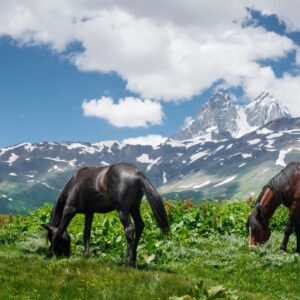 Feeding and Caring for Horses During Cold Weather: Healthy horses usually get along fine in moderately cold weather. A little more care may be necessary for very young or very old equines. In addition, those that are ill or have any sort of chronic health challenge. In extremely cold, wet, or windy weather, almost all horses will benefit from a few adjustments to management.
Feeding and Caring for Horses During Cold Weather: Healthy horses usually get along fine in moderately cold weather. A little more care may be necessary for very young or very old equines. In addition, those that are ill or have any sort of chronic health challenge. In extremely cold, wet, or windy weather, almost all horses will benefit from a few adjustments to management.
Shelter:
Shelter is important! Athough horses don’t necessarily have to be kept in stalls. Horses that are left outside, but with free access to shelter, will use a shed or building if they need it. Just getting out of a cold breeze is helpful in maintaining body warmth. The lee side of a hill, group of trees, or steep bank can be almost as good as a run-in shed or barn in breaking the force of a moderate wind. Owners should be sure that all horses have access to some type of sheltered area extensive enough so that dominant horses can completely exclude submissive members of the herd.
Staying Dry:
Staying dry is a big part of staying warm. The horse’s coat will shed some rain unless it lasts a long time or is driven by a strong wind. In severe weather, outdoor horses may benefit from waterproof blankets. However, blanketed horses should be checked several times a day to be sure the blanket fits well and doesn’t rub the horse’s coat.
Putting a blanket on a wet horse prevents the coat from drying. Therefore horses should be brought into a stall and allowed to dry completely before blankets are put on. In a pinch, a blanket can be put on a wet horse and fastened loosely. Use large handfuls of straw or hay placed at frequent intervals between the horse’s skin and the inside of the blanket so that air can circulate to help the coat dry. This is a temporary solution. The horse will need to have this blanket removed and a completely dry one put on before he is either left in the stall or turned out.
Providing Hay:
The horse generates a great deal of heat through the process of fermenting roughage in the hindgut. For this reason, providing more hay is the first step in keeping horses warm during cold weather. For moderate winter conditions with air temperatures down to the teens or single digits, the horse needs to have an amount of hay equal to about 1.5 to 2% of his body weight every day. As the temperature falls, another 2 to 3 lb (1 to 1.5 kg) of hay should be provided for every additional five degrees below zero (Fahrenheit). Young horses, older horses, and pregnant or lactating broodmares may need grain in addition to their forage ration. Increasing forage should be done before the grain ration is increased.
Clean Water:
Access to clean water that is not too cold is extremely important for horses during the winter season. Horses will drink water that is just above freezing. However, they will drink more if the water is somewhat warmer. Don’t count on horses eating snow to quench their thirst! This practice doesn’t supply much liquid and can seriously decrease the horse’s body temperature. Horses that don’t drink enough are at increased risk for impaction and choke, conditions that often require veterinary intervention. Be sure water supplies are not frozen and are adequate for all horses.
Resources:
In conclusion, do you have questions about Feeding and Caring for Horses During Cold Weather? Contact us at J & J Hay Farms by clicking here!
Article Sources: Kentucky Equine Research
